Analysis of Modal and Vibration Reduction of an Interior Permanent Magnet Synchronous Motor
Abstract
:1. Introduction
2. Basic Parameters of the Motor and Laboratory Testing Platform
2.1. Basic Parameters of the Motor and Magnetic Field Calculation Model
2.2. Laboratory Testing Platform
3. Analysis and Calculation of Electromagnetic Force
3.1. Basic Theories of Electromagnetic Force
3.2. Electromagnetic Force by FEM Calculation
4. Modal and Vibration Analysis
4.1. Motor Modal Analysis
4.2. Motor Vibration Test
4.3. Optimized Design and Research of Vibration
5. Conclusions
Author Contributions
Funding
Acknowledgments
Conflicts of Interest
References
- Dai, Y.; Cui, S.M.; Song, L.W. Finite element method modal analysis of driving motor for electric vehicle. Proc. CSEE 2011, 319, 100–104. [Google Scholar]
- Yang, Z.L.; Wang, S.M.; Hong, J.F. Analysis of electromagnetic exciting force and vibration of rotating armature permanent magnet synchronous motor. J. Eng. 2018, 2018, 1903–1908. [Google Scholar] [CrossRef]
- Jang, I.S.; Ham, S.H. Method for analyzing vibrations due to electromagnetic force in electric motors. IEEE Trans. Magn. 2014, 502, 297–300. [Google Scholar] [CrossRef]
- Zheng, J.; Dai, Y.; Shi, J. Electromagnetic noise characteristics of permanent magnet synchronous motor applied in electric vehicle. Trans. China Electrotech. Soc. 2016, 31, 53–59. [Google Scholar]
- Liu, C.M.; Cao, G.Z.; Huang, S.D. Modal analysis and linear static structure analysis of linear switched reluctance motor. In Proceedings of the 2014 4th IEEE International Conference on Information Science and Technology, Shenzhen, China, 26–28 April 2014. [Google Scholar]
- Calin, I.; Filip, F.; Helerea, E. Three-phase squirrel-cage induction motor modal analyses. Theoretical and experimental aspects. In Proceedings of the 2012 13th International Conference on Optimization of Electrical and Electronic Equipment (OPTIM), Brasov, Romania, 24–26 May 2012. [Google Scholar]
- Xie, Y.; Wang, Y.; Lv, S. Modal calculation and test of small asynchronous motor. Trans. China Electrotech. Soc. 2015, 3016, 1–9. [Google Scholar]
- Liu, D.Z. Modal analysis of induction motor stator. Drive Syst. Tech. 2016, 303, 24–29. [Google Scholar]
- Wang, K.; Wang, X.H.; Tian, M.M. The model analysis of the stator of the interior permanent magnet machine. In Proceedings of the 2017 20th International Conference on Electrical Machines and Systems (ICEMS), Sydney, Australia, 11–14 August 2017. [Google Scholar]
- Wang, K.; Wang, X.H. The model analysis of the stator of the interior permanent magnet synchronous motor. In Proceedings of the 2017 IEEE Transportation Electrification Conference and Expo, Asia-Pacific (ITEC Asia-Pacific), Harbin, China, 7–10 August 2017. [Google Scholar]
- Chai, F.; Li, Y.; Pei, Y.L. Accurate modelling and modal analysis of stator system in permanent magnet synchronous motor with concentrated winding for vibration prediction. IET Electr. Power Appl. 2018, 128, 1225–1232. [Google Scholar] [CrossRef]
- Li, X.H.; Huang, S.R.; Zhang, Q. Analysis of natural frequencies of stator structure of permanent magnet synchronous motors for electric vehicles. Proc. CSEE 2017, 378, 2383–2390. [Google Scholar]
- Doyeon, K.; Jeongyong, S. Magnetic and structural finite element analysis of rotor vibrations due to magnetic forces in IPM motor. IEEE Trans. Magn. 2014, 50, 502. [Google Scholar]
- Wang, L.; Bao, X.H.; Di, C. Influence on vibration and noise of squirrel-cage induction machine with double skewed rotor for different slot combinations. IEEE Trans. Magn. 2016, 52, 1–4. [Google Scholar] [CrossRef]
- Lee, J.Y.; Chang, J.H. Analysis of the vibration characteristics of coaxial magnetic gear. IEEE Trans. Magn. 2017, 53, 1–4. [Google Scholar] [CrossRef]
- Chen, Y.G.; Han, B.R.; Shen, Y.H. Electromagnetic vibration analysis of permanent magnet synchronous propulsion motor. Trans. China Electrotech. Soc. 2017, 3223, 16–22. [Google Scholar]
- Li, X.; Yang, K.M.; Zhu, Y. Research on vibration suppression for planar motors on the basis of modal force constraint. Proc. CSEE 2015, 3512, 3124–3131. [Google Scholar]
- Yang, X.D.; Bai, R.L.; Yu, S.L. Fractional-Slot Surface-Mounted Permanent Magnet Synchronous Motor Vibration. Small Spec. Electr. Mach. 2017, 45, 18–20. [Google Scholar]
- Zhang, R.; Wang, X.H.; Qiao, D.W.; Yang, Y.B. Reduction of Exciting Force Wave for Permanent Magnet Motors by Teeth Notching. Proc. CSEE 2010, 3018, 103–108. [Google Scholar]
- Zang, X.; Wang, X.H.; Yang, Y.B.; Wei, B. Vibration Reduction of a Switchen Reluctance Motor Using New Rotor Tooth with Slot on Each Side. Proc. CSEE 2015, 356, 1508–1515. [Google Scholar]
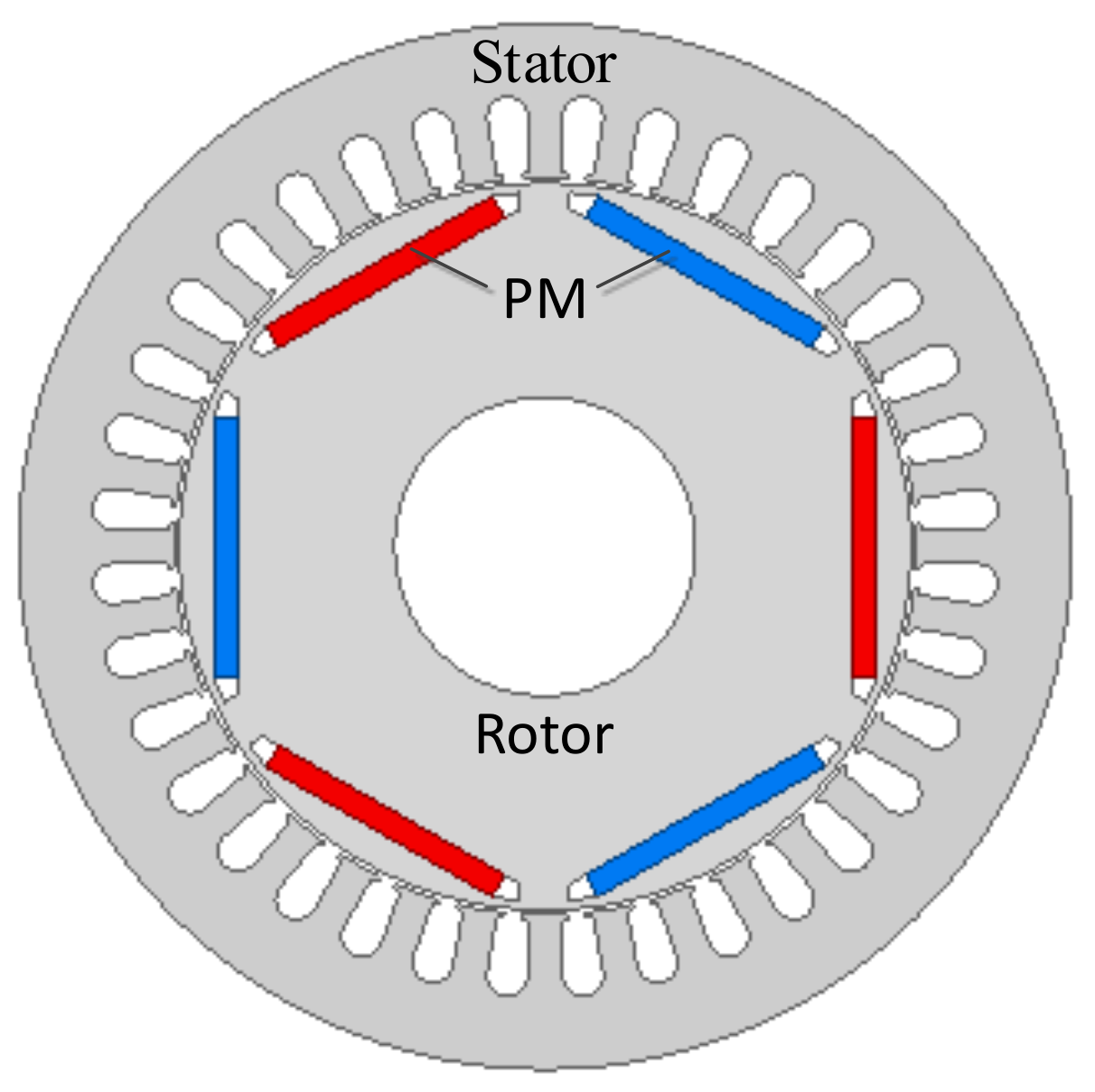
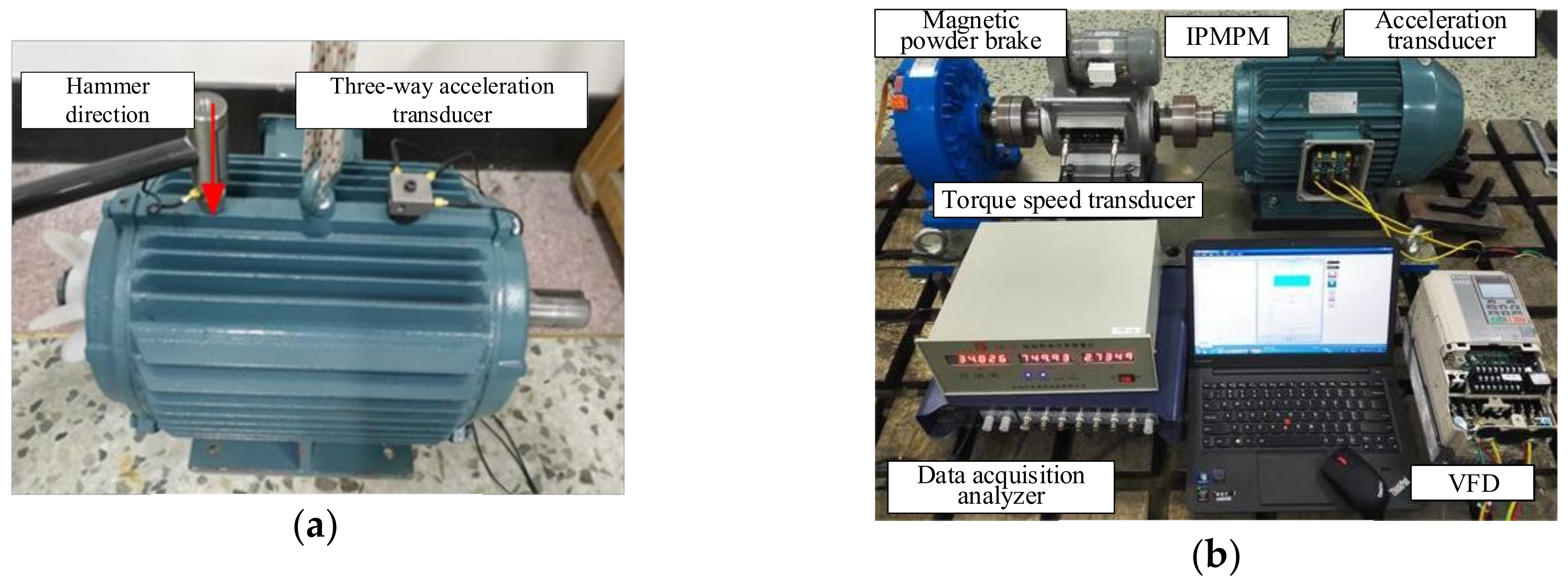
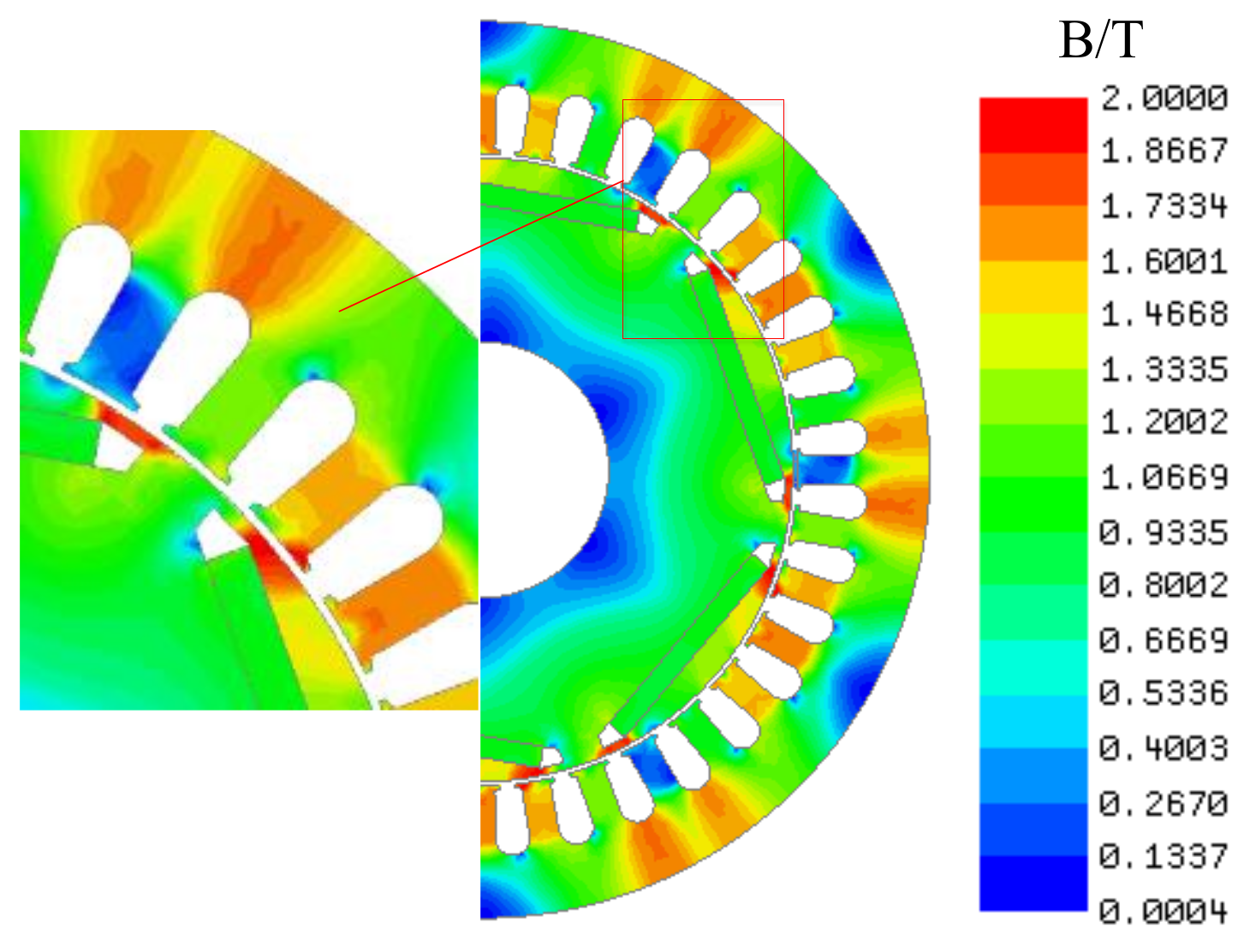
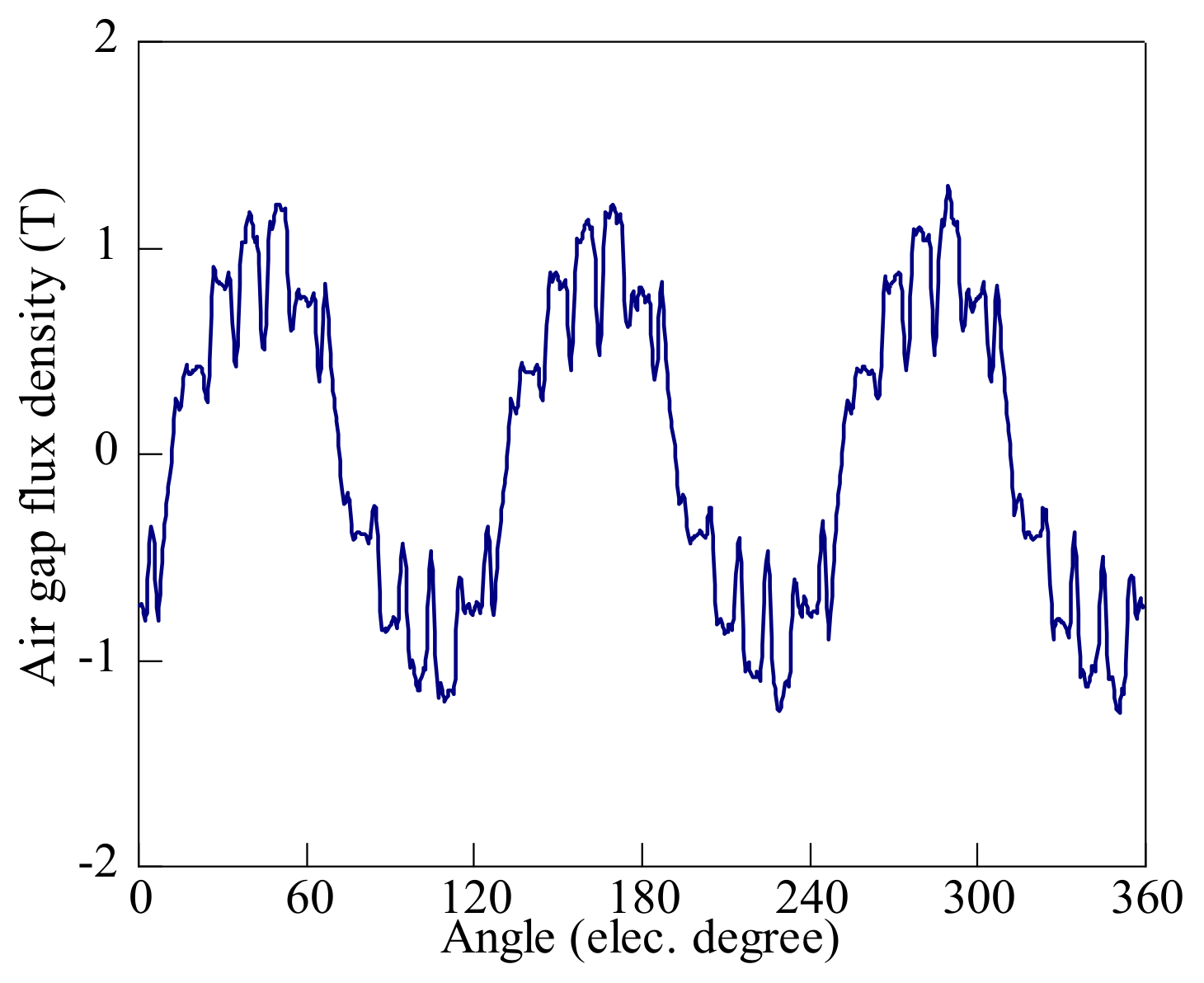

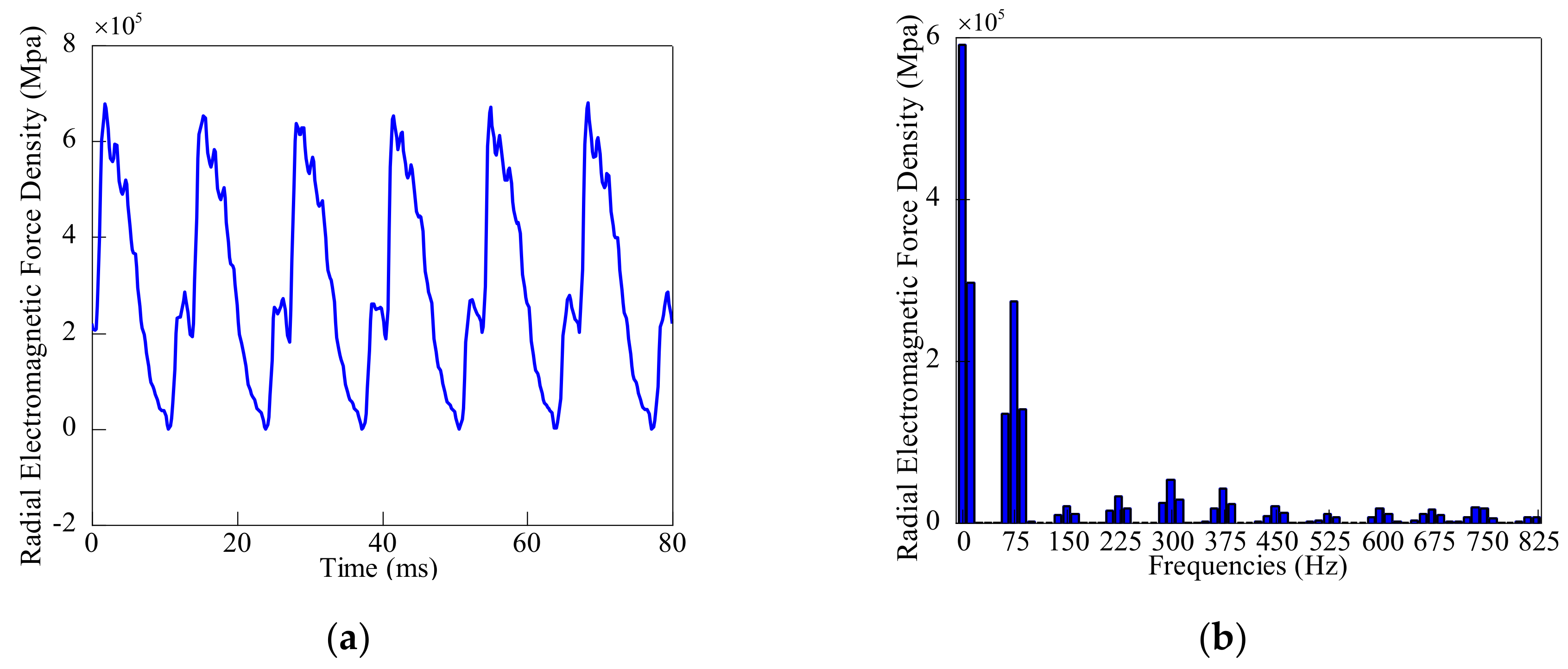
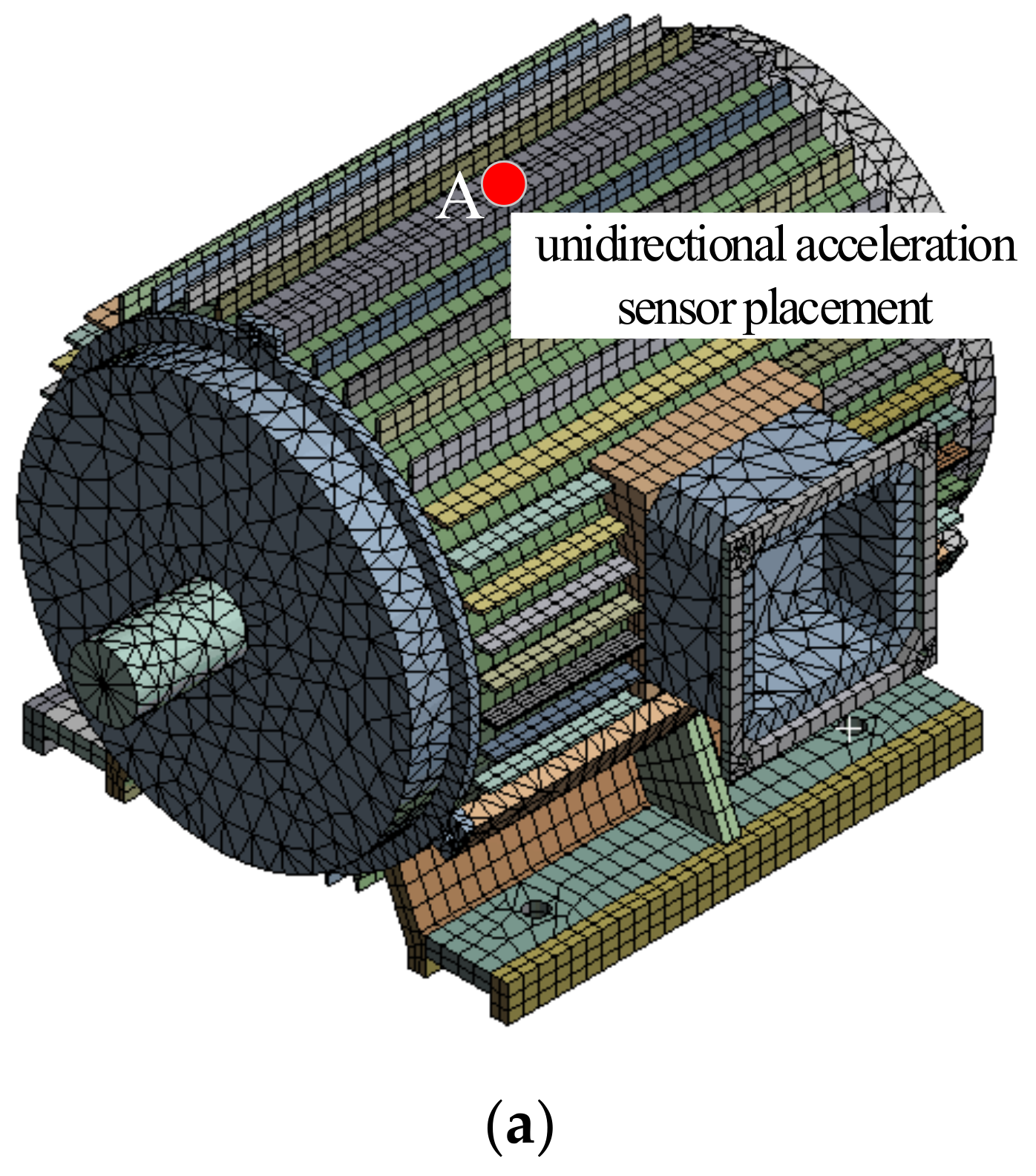
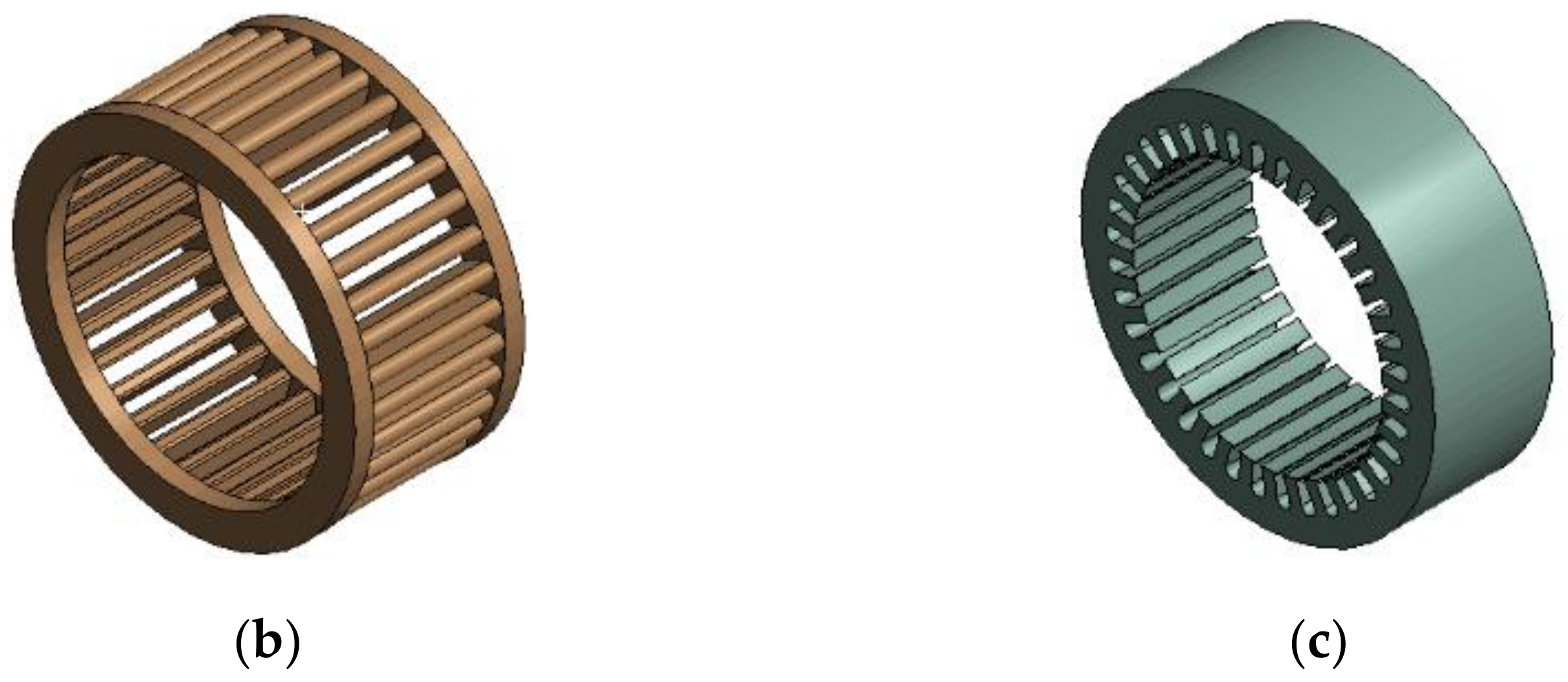
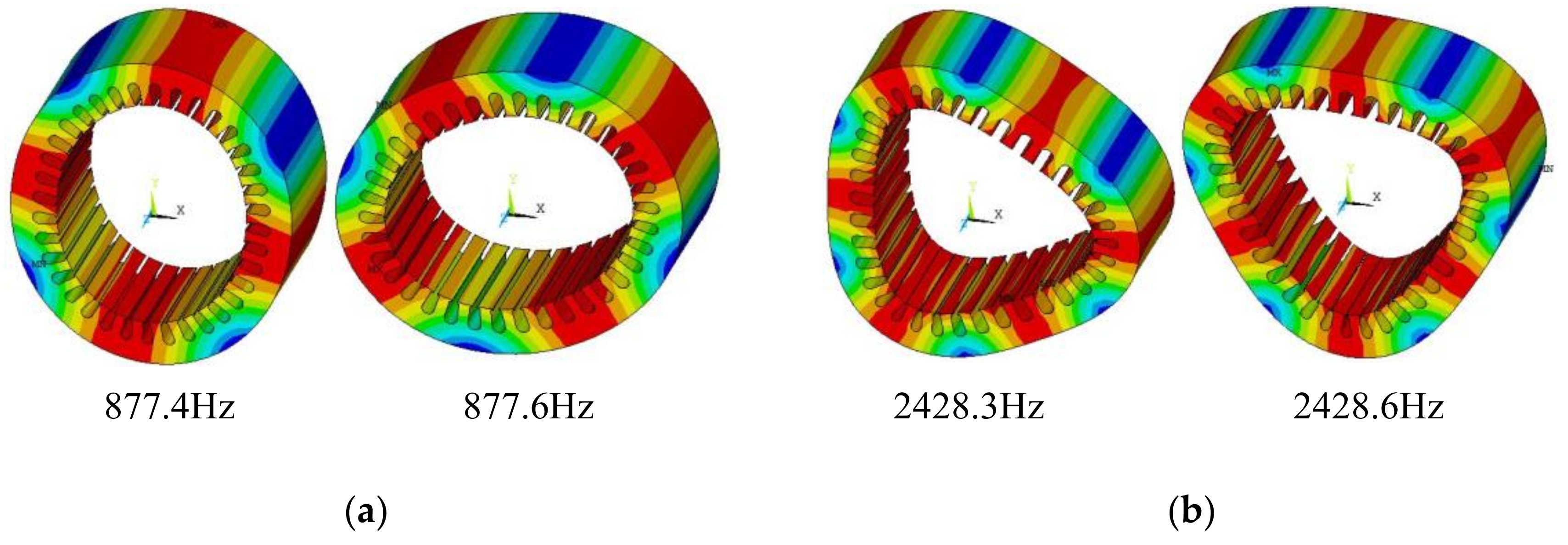
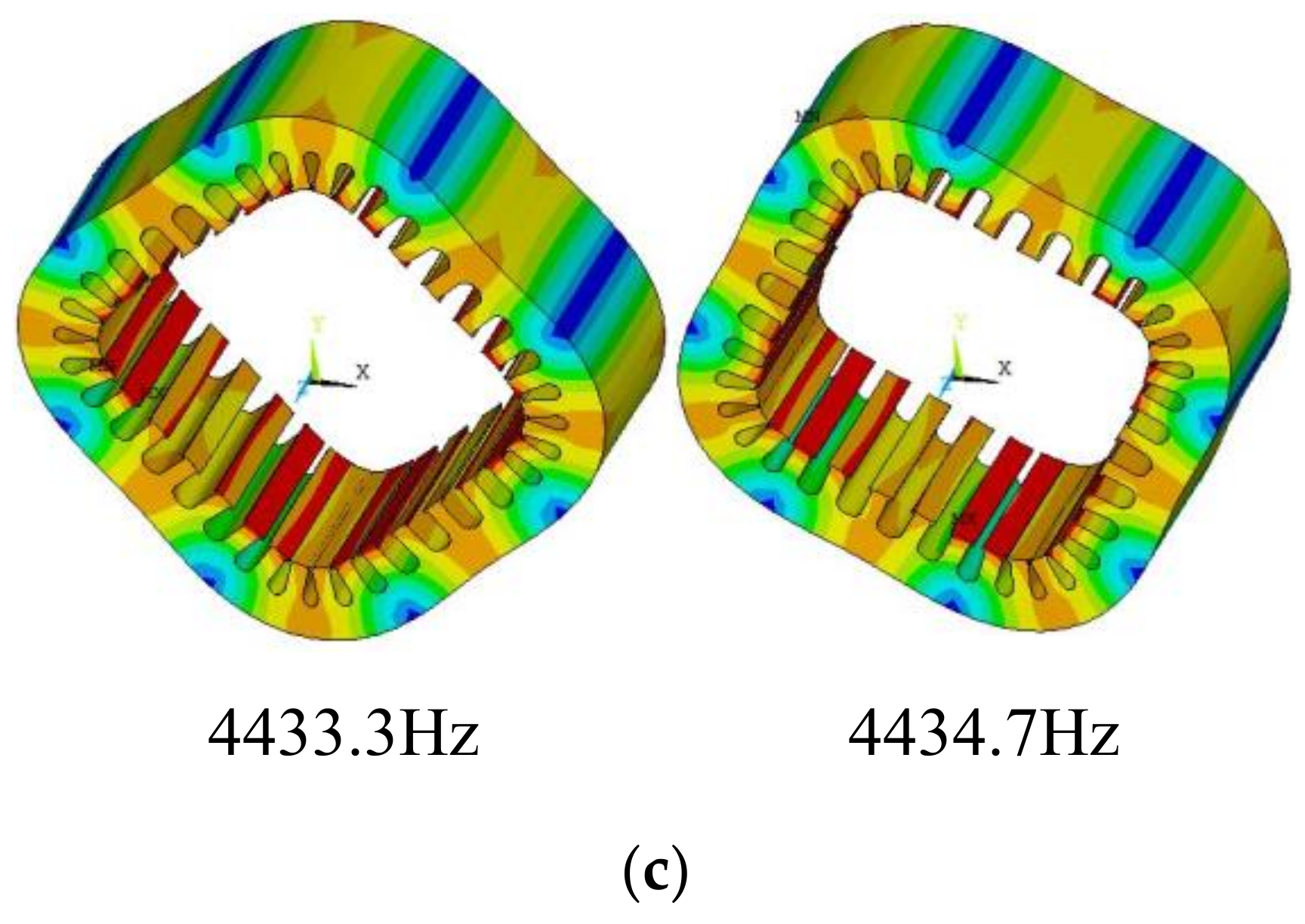






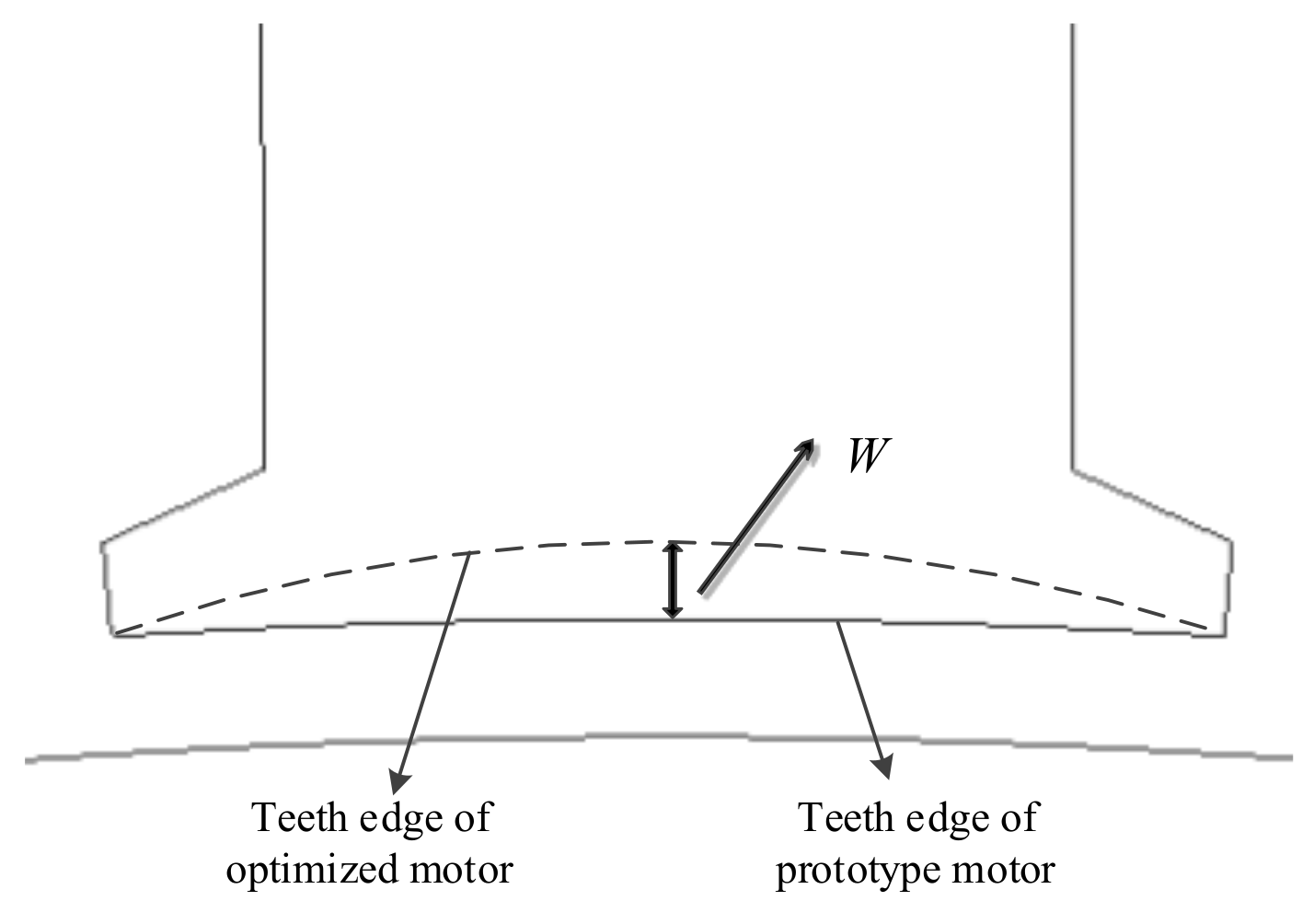
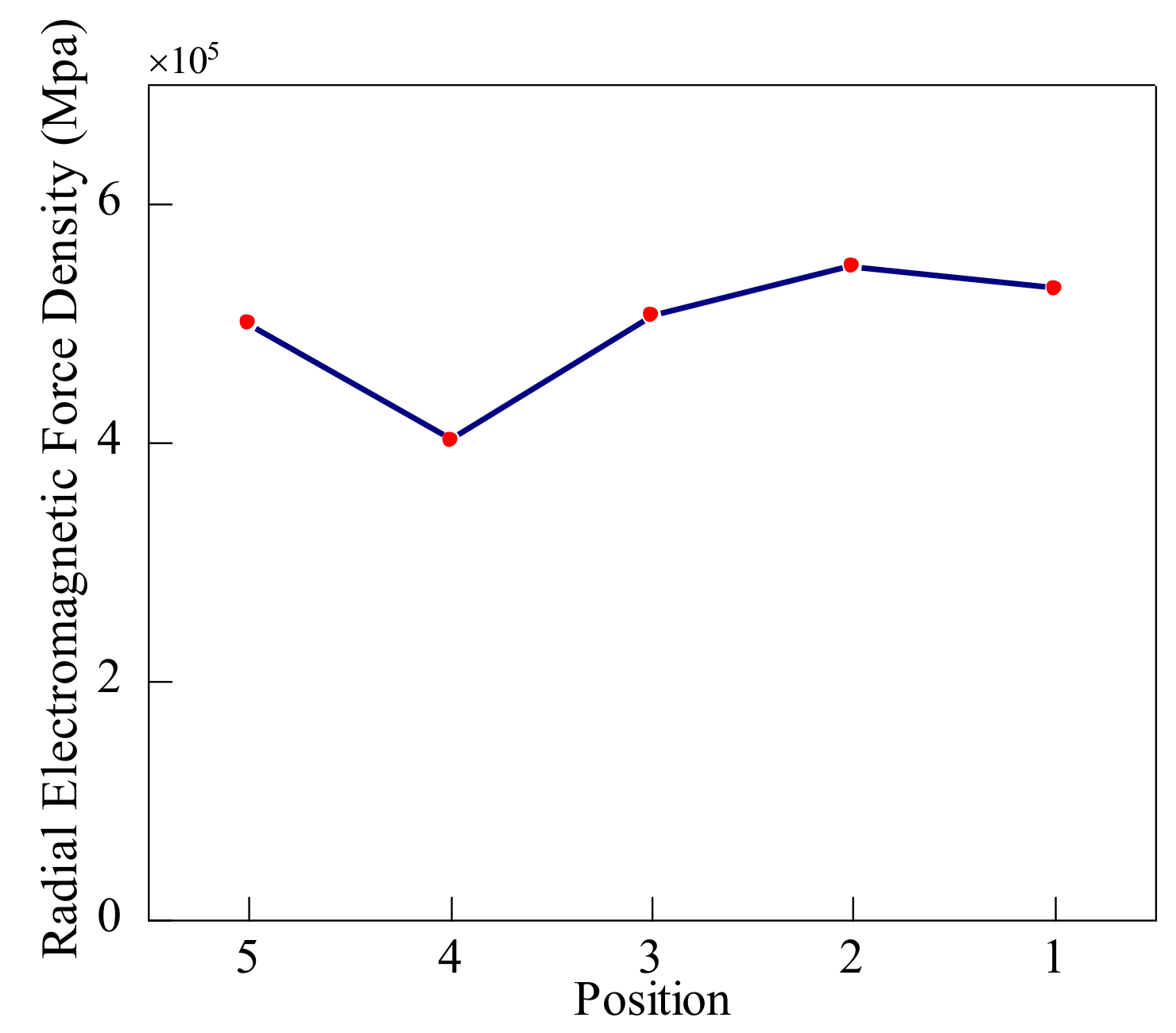
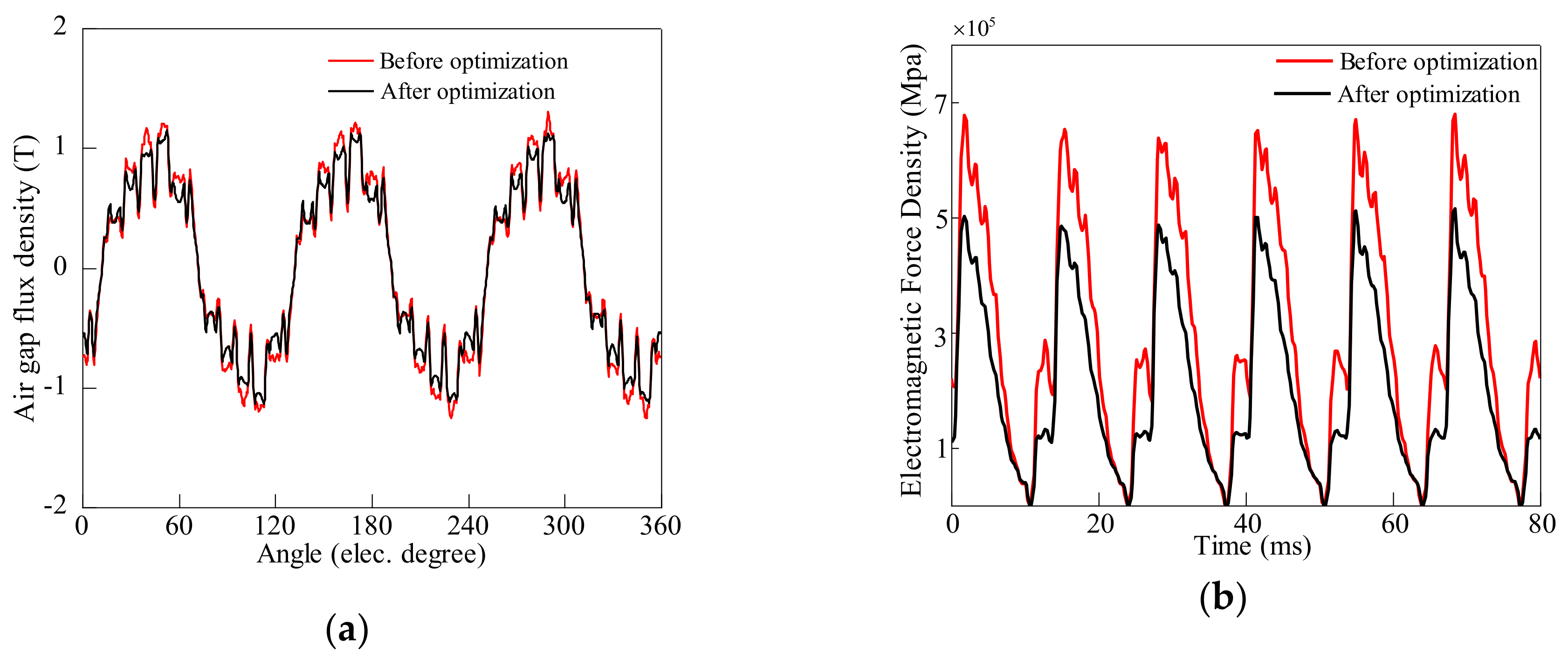

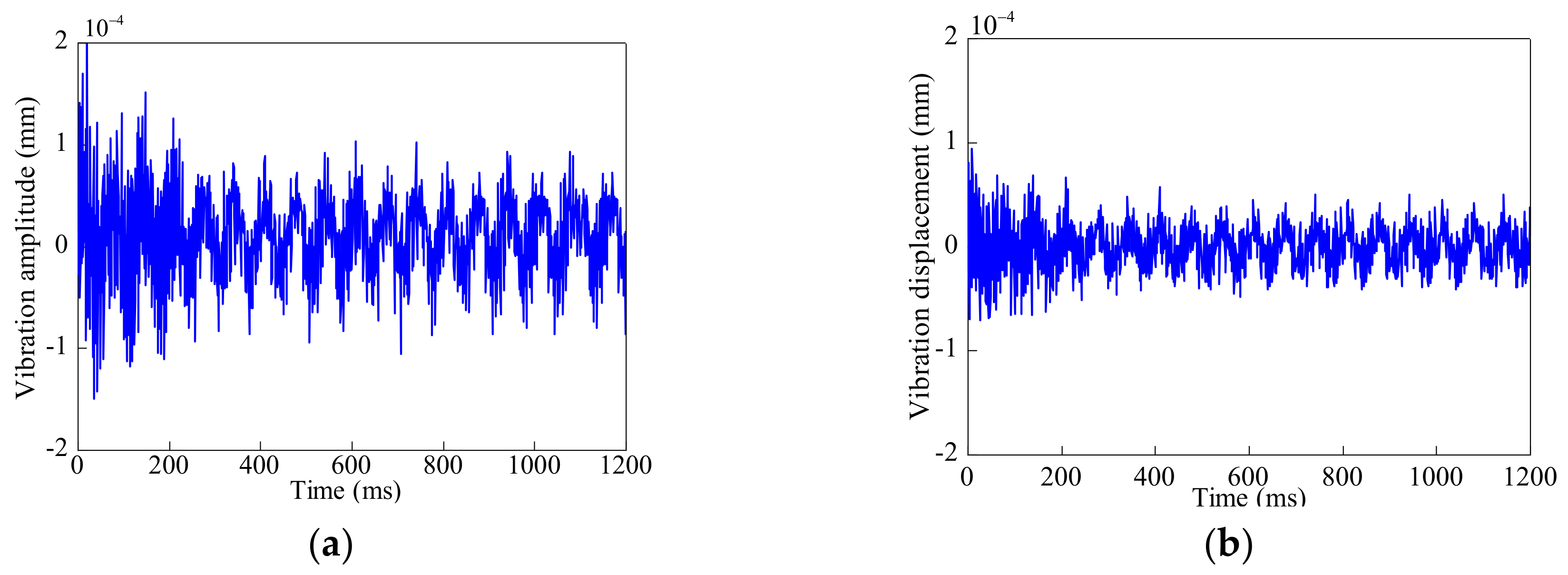
| Parameter | Value | Parameter | Value |
|---|---|---|---|
| Rated power | 3 kW | Stator outer radius | 105 mm |
| Rated voltage | 380 V | Stator inner radius | 74 mm |
| Rated frequency | 37.5 Hz | Air gap length | 1 mm |
| Rated speed | 750 rpm | Rotor inner radius | 30 mm |
| Number of stator slot | 36 | Magnetic bridge thickness | 1.8 mm |
| Number of rotor pole-pair | 6 | Core height | 70 mm |
| Wind method | Star | Wind layers | 2 |
| Parallel branches | 1 | Coil pitch | 5 |
| 3 | −15 | 21 | −33 | 39 | −51 | 57 | ||
|---|---|---|---|---|---|---|---|---|
| 3 | 0 | −12 | 18 | −30 | 36 | −48 | 54 | |
| 9 | 6 | −6 | 12 | −24 | 30 | −42 | 48 | |
| 15 | 12 | 0 | 6 | −18 | 24 | −36 | 42 | |
| 21 | 18 | 6 | 0 | −12 | 18 | −30 | 36 | |
| 27 | 24 | 12 | 6 | −6 | 12 | −24 | 30 | |
| 33 | 30 | 18 | 12 | 0 | 6 | −18 | 24 | |
| 39 | 36 | 24 | 18 | 6 | 0 | 12 | 18 | |
| Part Name | Material | Density | Elastic Modulus | Poisson’s Ratio |
|---|---|---|---|---|
| Casing End cap Junction box | Cast iron | 7000 kg/m3 | 1.25 × 1011 Pa | 0.25 |
| Iron core | 50 W470 | 7305 kg/m3 | 2.05 × 1011 Pa | 0.3 |
| Magnetic steel | 35 SH | 7540 kg/m3 | 1.68 × 1011 Pa | 0.24 |
| Rotation shaft | 1045080 M46 | 7850 kg/m3 | 2.10 × 1011Pa | 0.27 |
| Equivalent winding | copper | 5800 kg/m3 | 1.20 × 109 Pa | 0.3 |
| Mode | Frequency (Hz) |
|---|---|
| Mode 2 | 877.4 877.6 |
| Mode 3 | 2428.3 2428.6 |
| Mode 4 | 4433.3 4434.7 |
| Mode | Simulated (Hz) | Test (Hz) | Error (%) |
|---|---|---|---|
| Mode 1 | 790.8 791.9 | 762.5 | 3.71 3.86 |
| Mode 2 | 1204.8 1352.5 1438.3 | 1265.0 1380.0 1466.3 | 4.76 1.99 1.91 |
| Mode 2(radial) | 1907.5 1977.4 | 1882.5 | 1.33 5.04 |
| Project | Average Torque (Nm) | Torque Ripple (Nm) |
|---|---|---|
| Prototype motor | 34.78 | 12.67 |
| Optimized motor | 33.32 | 6.41 |
© 2019 by the authors. Licensee MDPI, Basel, Switzerland. This article is an open access article distributed under the terms and conditions of the Creative Commons Attribution (CC BY) license (http://creativecommons.org/licenses/by/4.0/).
Share and Cite
Xie, Y.; Xia, Y.; Li, Z.; Li, F. Analysis of Modal and Vibration Reduction of an Interior Permanent Magnet Synchronous Motor. Energies 2019, 12, 3427. https://doi.org/10.3390/en12183427
Xie Y, Xia Y, Li Z, Li F. Analysis of Modal and Vibration Reduction of an Interior Permanent Magnet Synchronous Motor. Energies. 2019; 12(18):3427. https://doi.org/10.3390/en12183427
Chicago/Turabian StyleXie, Ying, Yu Xia, ZhiWei Li, and Fei Li. 2019. "Analysis of Modal and Vibration Reduction of an Interior Permanent Magnet Synchronous Motor" Energies 12, no. 18: 3427. https://doi.org/10.3390/en12183427




